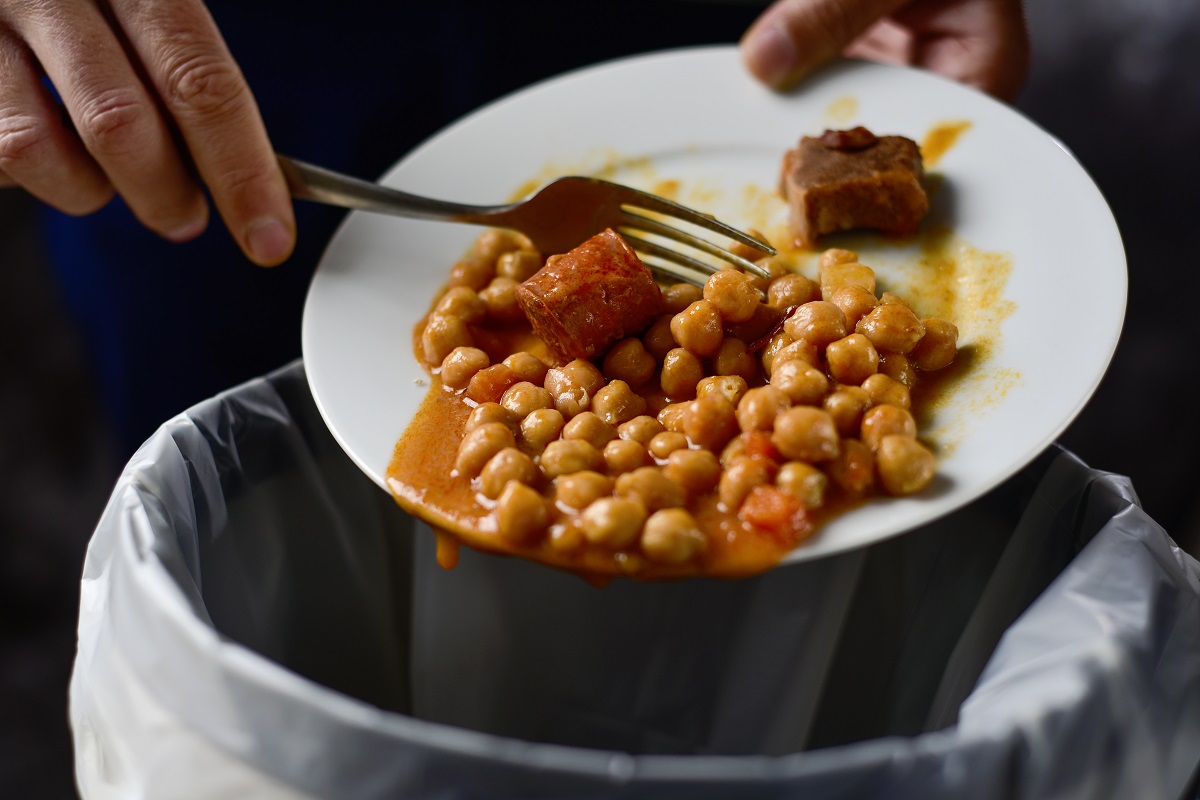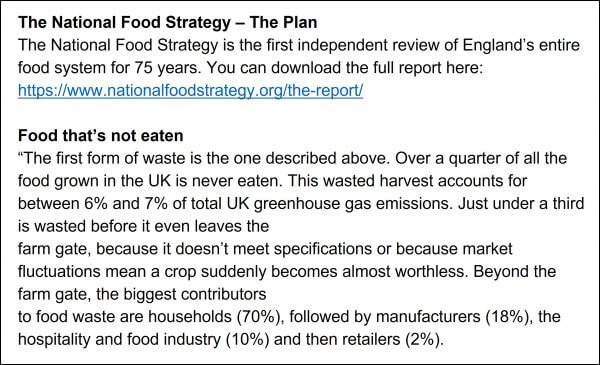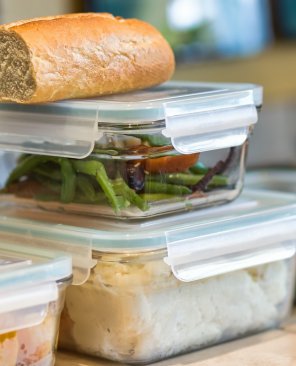
07 Feb 2022 Food waste – small steps to have a positive impact on food sustainability
Let’s look at food waste differently, and eat our way to a healthy and sustainable future!
2021 was a year for bold statements when it came to climate change, food sustainability and global health targets. Interwoven amongst the many targets to address these issues is the often-overlooked issue of food waste. In the light of the COP26 agreement to achieve net zero greenhouse gas emissions by 2050 and the publication of the UK’s National Food Strategy (1) it is clear that climate change is at the forefront of policymakers’ minds. However, the scale and impact that food waste has towards contributing to climate change makes for some sobering statistics.

The UK is targeted with reducing food waste by 50% by 2030 from 2007 baseline levels (1). In order to achieve this, governments have multiple approaches to tackling food waste throughout the supply chain and waste management streams. However, once fresh food leaves the farm gate, 70% of food waste occurs in the home. This demonstrates that we, as individuals can make small changes that will have a big impact on our health, our pocket and contribute to a sustainable future for the planet.
On average, around one third of the precious food we produce, is wasted. If that isn’t shocking enough, in terms of the carbon footprint, were food waste to be a country, it would be the third largest emitter of greenhouse gases after the United States and China.
 As individuals, we in the UK throw away around 4.5 million tonnes of food waste at home per year (2). This is not only a waste of the resources and energy used to produce the food, it also increases waste for landfill. Food waste in landfill produces methane (a greenhouse gas) which is even more potent than CO2 in contributing to climate change. In addition, as food passes through the supply chain, the carbon footprint intensifies, so by the time food is thrown away at home, it has already produced 37% of the total carbon footprint of that product (3). You can look at the carbon footprint of foods and see how they compare using this Carbon Footprint Food Calculator
As individuals, we in the UK throw away around 4.5 million tonnes of food waste at home per year (2). This is not only a waste of the resources and energy used to produce the food, it also increases waste for landfill. Food waste in landfill produces methane (a greenhouse gas) which is even more potent than CO2 in contributing to climate change. In addition, as food passes through the supply chain, the carbon footprint intensifies, so by the time food is thrown away at home, it has already produced 37% of the total carbon footprint of that product (3). You can look at the carbon footprint of foods and see how they compare using this Carbon Footprint Food Calculator
‘Sustenance and sustainability’
It is not all bad news though as there is a lot that can be done when it comes to minimising food waste at home. Some easy, straight forward tips on how to optimise food purchases, food storage, cooking methods, portion size and limiting or repurposing waste, can help tick both the health and sustainability boxes.
Focus on appreciating your apples and treasuring your tomatoes. A few small steps can help to add more nutrients to your meals, save you time, and be kind on our pocket, what isn’t to like?
When heading to the supermarket, plan ahead.
- First of all, check what food you already have in the fridge and pantry and their sell-by dates and consider how you can use that up? Download our client pantry staples guide here.
- Write a shopping list to carefully select the ingredients needed to compliment those already in house and avoid purchasing things you already have.
- This may go hand in hand with meal planning to map out what to eat over the coming week. Download the BANT Food for your Health weekly Meal Planner here.
- Avoid shopping when hungry as temptations can take over and lead to impulse purchases which later end up in the bin.
- Stick to your shopping list and only buy what is needed. Tempting ‘buy one get one free’ offers, or short-dated produce are great if you think they can all be used up, but if half might go to waste, think again.
- Shop the foods that are in season. Seasonal produce is often locally grown and sourced giving it a lower carbon footprint. It is typically fresher, naturally ripened and more nutrient-dense (especially when compared to imported produce). Furthermore, seasonal vegetables are typically more abundant and therefore noticeably cheaper. Download our fill your fridge with fresh produce guide here and Seasonal Food guide here.
- Consider frozen produce such as fruits, vegetables, and fish – they last longer and are typically high in nutrients since they are frozen directly after harvest/catch. Frozen foods can substitute fresh ingredients and limit potential waste and are available all-year round. Similarly, you can freeze your own purchases or home-grown produce. Download our Freezer Ingredient guide here.
Download our Shopping Strategies guide here.
You don’t have to create new meals every-day. Here are some organisational tips to make the most of your food shop, and time preparing meals.
Cooking from scratch, although typically healthier than convenience foods, can lead to higher levels of food waste if more food than is necessary is bought and prepared. Around 25% of food waste is created from people cooking and then not eating leftovers of the meals that they prepare.
- Organised batch-cooking and food storage. This can help you reduce waste and save time and money. Food safe containers ensure meals can be optimally portioned to limit leftovers and then stored in the fridge or freezer. You can then rotate between prepared-meals and those you might choose to prepare fresh to optimise your meal variety and limit eventual food waste.
- Consider the rule of three: how can this product, for example a vegetable, be used in three different ways, for example, a soup, a salad and in a pasta dish! Much food waste comes from not knowing how to use ingredients in more than one way, meaning it gets left to degrade and is thrown away.
- Aim for food-friendly cooking methods to reduce the environmental impact of your meals, and which also preserve the nutrient value of ingredients such as gentle steaming, poaching and air-frying versus BBQing, deep- frying and other high heat methods.
- Consider your by-products of cooking. Peelings can be used in a compost bin and create the ultimate 360-degree approach to give the nutrients back to the earth if you have an allotment or vegetable patch, or can be responsibly recycled in food bins. Many other off-cuts can be used as a base to make stocks and soups prolonging the life of that product and reducing its carbon footprint and waste.
Don’t be too quick to bin your leftovers, perceived waste and over-ripe items
- Transform perceived waste into something else. Take bread for example (one of the largest contributors to food waste), it can be dried out, whizzed up and stored as breadcrumbs. Or day-old bread can be chopped into croutons and roasted with a little oil and stored in an airtight container to use on top of soups and salads. Better yet, and before it gets to this stage, you can consider freezing a sliced loaf and only defrosting the number of slices that are needed each day.
- Bring dehydrated greens back to life by bathing in ice cold water for 15 mins.
- Use over-ripe fruit in smoothies, cakes or crumbles.
- Use up leftover vegetables in stir-fries, pasta dishes, soups, sandwiches and slaws.
- Boil up leftover roast dinner and/or fish bones for a hearty broth.
- And if all else fails, go back to your freezer to store leftovers for another day making sure to consider storage methods and labeling containers.
Effective storage methods such as the following can extend the life of many purchased foods
- Review fridge temperature – fridges should be set below 5 degrees Celsius
- Review also ambient temperature in the kitchen, pantry or other location where foods might be stored. Heat is one of the quickest ways that foods spoil and end up being thrown away.
- Use storage bags and containers to stop fruits, vegetables, dairy products and other foods from dehydrating in the fridge.
- Portion food into containers and freeze what you don’t wish to use straight away.
- Invest in a range of air-tight containers or re-use jars to store dry goods that might degrade or spoil if left open in packets, such as nuts, seeds, herbs and spices. Download our Food Storage guide here.
Lastly, take a look at your portion size?
- Scale back on portion size if you regularly have leftovers that get thrown away. You can always come back for seconds if needed.
- Aim to only prepare / cook what is needed at each meal and/or batch cook and portion accordingly. In doing so there will be little or no leftovers or wastage.
- Review your crockery. The trend for over-sized restaurant-style crockery at home has led to a distinct increase in portion sizes and corresponding food waste. Down-sizing to a more traditional size plate, bowl, mug, and glass may be effective in itself at guiding portion size.
For more hints and tips go to Love Food Hate Waste
It makes financial sense
Taking positive steps towards valuing the food you buy will not only unlock its nutritional value, it can also save you money! According to WRAP (The Waste and Resource Action Programme), a family of four can save around £700 per year by cutting down on their food waste (4). It’s a win-win. Increasing your nutrient availability whilst lining your pockets and saving the planet. We are all in this together. As a nation we are making positive strides towards tackling food waste, so small changes you make at home will have a lasting impact on the health and wellness of you and the planet.
Download our Food for your Health guide on Food Waste
Contributors:
Author Helen Amiri, Nutritional Therapy & BSc Student, CNELM
Co-author and Editor, Claire Sambolino. BANT Registered Nutritionist ®
References:
- National Food Strategy, Part 2, Chapter 11 (2021); https://www.nationalfoodstrategy.org/the-report/
- https://www.lovefoodhatewaste.com/why-save-food
- https://www.fao.org/3/bb144e/bb144e.pdf
- https://wrap.org.uk/taking-action/food-drink/actions/action-on-food-waste





